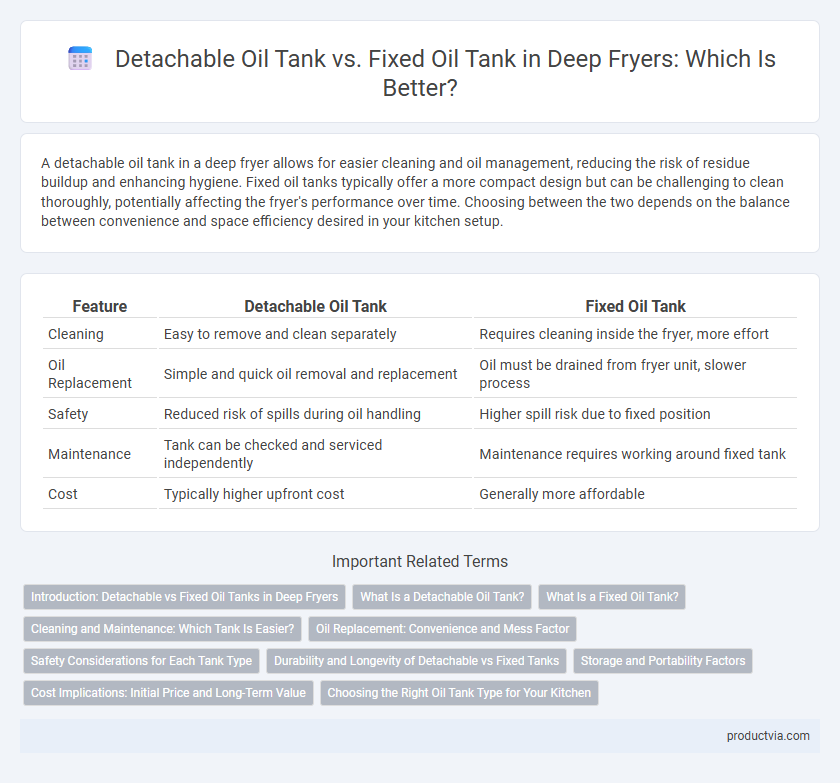A detachable oil tank in a deep fryer allows for easier cleaning and oil management, reducing the risk of residue buildup and enhancing hygiene. Fixed oil tanks typically offer a more compact design but can be challenging to clean thoroughly, potentially affecting the fryer's performance over time. Choosing between the two depends on the balance between convenience and space efficiency desired in your kitchen setup.
Table of Comparison
| Feature | Detachable Oil Tank | Fixed Oil Tank |
|---|---|---|
| Cleaning | Easy to remove and clean separately | Requires cleaning inside the fryer, more effort |
| Oil Replacement | Simple and quick oil removal and replacement | Oil must be drained from fryer unit, slower process |
| Safety | Reduced risk of spills during oil handling | Higher spill risk due to fixed position |
| Maintenance | Tank can be checked and serviced independently | Maintenance requires working around fixed tank |
| Cost | Typically higher upfront cost | Generally more affordable |
Introduction: Detachable vs Fixed Oil Tanks in Deep Fryers
Detachable oil tanks in deep fryers offer easy cleaning and convenient oil replacement, enhancing maintenance efficiency and extending the fryer's lifespan. Fixed oil tanks provide a more compact design with fewer parts, often ensuring better heat retention and stability during frying. Choosing between detachable and fixed tanks depends on the priorities of ease of use versus durability and design compactness.
What Is a Detachable Oil Tank?
A detachable oil tank in a deep fryer is a removable container designed to hold cooking oil, allowing for easy extraction, cleaning, and oil replacement. This feature enhances convenience by simplifying maintenance and improving hygiene, as the tank can be detached without dismantling the entire appliance. Detachable oil tanks are especially beneficial in commercial kitchens where frequent oil changes are necessary to maintain food quality and fryer performance.
What Is a Fixed Oil Tank?
A fixed oil tank in a deep fryer is a built-in reservoir that remains permanently attached to the appliance, designed to hold cooking oil securely during frying. This type of tank offers stability and often better heat retention, ensuring consistent frying temperatures. Maintenance typically involves cleaning the entire unit, which may require more effort compared to models with detachable oil tanks.
Cleaning and Maintenance: Which Tank Is Easier?
Detachable oil tanks in deep fryers significantly simplify cleaning by allowing users to remove the tank entirely for thorough washing, preventing oil residue buildup and reducing odors. Fixed oil tanks require careful wiping and often intricate cleaning around heating elements, making maintenance more time-consuming and less effective. Users seeking convenience and hygiene typically prefer detachable tanks due to their easier access and faster maintenance process.
Oil Replacement: Convenience and Mess Factor
Detachable oil tanks in deep fryers significantly simplify oil replacement by allowing users to remove the tank entirely, minimizing spills and cleanup time. Fixed oil tanks often require careful handling during oil draining, increasing the risk of mess and prolonging maintenance. Choosing a detachable tank enhances convenience and reduces the hassle associated with oil disposal and refilling.
Safety Considerations for Each Tank Type
Detachable oil tanks in deep fryers enhance safety by allowing users to easily remove and clean the oil, reducing the risk of spills and burns during maintenance. Fixed oil tanks, while more stable during operation, can pose higher hazards during cleaning as hot oil must be handled within the fryer unit, increasing spill risk. Proper safety protocols, such as cooling the oil before any maintenance, are critical regardless of tank type to prevent burns and fire hazards.
Durability and Longevity of Detachable vs Fixed Tanks
Detachable oil tanks in deep fryers typically offer enhanced durability due to ease of cleaning and reduced risk of oil residue buildup, which can degrade materials over time. Fixed oil tanks often face challenges with thorough cleaning, leading to faster wear and potential corrosion that shortens the fryer's lifespan. Choosing a detachable tank improves longevity by maintaining optimal oil quality and minimizing structural damage caused by trapped contaminants.
Storage and Portability Factors
Detachable oil tanks in deep fryers offer significant advantages in storage and portability by allowing users to remove and store the tank separately, reducing the overall appliance size and easing cleaning. Fixed oil tanks increase the fryer's bulkiness, making it less convenient to store in compact spaces or transport between locations. Portability is enhanced with detachable tanks since they minimize spills and simplify oil disposal, essential for safe handling and mobility.
Cost Implications: Initial Price and Long-Term Value
Detachable oil tanks in deep fryers typically have a higher initial price due to their convenience and ease of cleaning, which can reduce maintenance costs over time. Fixed oil tanks often come at a lower purchase cost but may incur higher long-term expenses from more frequent professional cleaning and potential oil degradation. Evaluating the total cost of ownership highlights that detachable oil tanks provide better long-term value despite the higher upfront investment.
Choosing the Right Oil Tank Type for Your Kitchen
Choosing the right oil tank type for your deep fryer depends on kitchen space and maintenance preferences. Detachable oil tanks offer easy cleaning and oil replacement, ideal for busy kitchens prioritizing hygiene. Fixed oil tanks provide a compact design with fewer parts but may require more effort for thorough cleaning and oil changes.
Detachable Oil Tank vs Fixed Oil Tank for Deep Fryer Infographic

 productvia.com
productvia.com